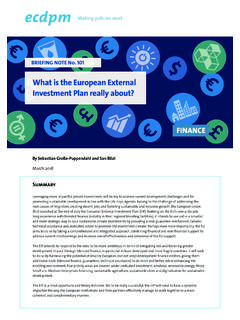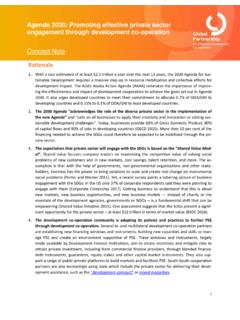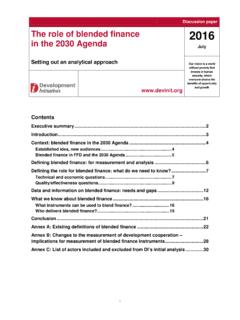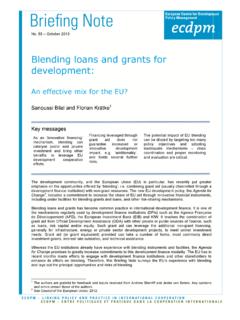Transcription of BLENDED FINANCE FOR DEVELOPMENT Bridging …
1 DEVELOPMENT CO-OPERATION DIRECTORATE DEVELOPMENT CO-OPERATION DIRECTORATE DEVELOPMENT CO-OPERATION DIRECTORATE Better Investments in DEVELOPMENT WHAT IS BLENDED FINANCE ? BLENDED FINANCE is the strategic use of DEVELOPMENT FINANCE for the mobilisation of additional FINANCE towards sustainable DEVELOPMENT in developing countries . $ trillion annual SDG shortfall in developing countries 189 BLENDED FINANCE funds launched since 2000 $31 billion committed in donor facilities towards blending since 2000 $81 billion mobilised from the private sector by official DEVELOPMENT FINANCE in 3 years WHY IS BLENDED FINANCE IMPORTANT FOR DEVELOPMENT ? Understanding the indispensable role of official DEVELOPMENT FINANCE in funding the Sustainable DEVELOPMENT Goals (SDGs), the international community has acknowledged the need for significant additional DEVELOPMENT FINANCE and accorded a prominent place to private sector participation.
2 The vision underpinning the 2030 Agenda is broad and ambitious, calling for an equally broad and ambitious financing strategy. In this context, the role of BLENDED FINANCE in mobilising private FINANCE for DEVELOPMENT results is gaining prominence. At the same time, the increasing emphasis on BLENDED FINANCE approaches evokes the need to increase the understanding and transparency of these flows. HOW WE CAN WORK TOGETHER TO ADVANCE BLENDED FINANCE FOR DEVELOPMENT ? The OECD/DAC work programme on BLENDED FINANCE will distil and promote best practice and develop guidance that will assist the DEVELOPMENT co-operation community in delivering DEVELOPMENT impact from emerging BLENDED FINANCE approaches that are Evidence based: Collate evidence and lessons learned on BLENDED FINANCE with a focus on targeting private FINANCE and the use of BLENDED FINANCE across different regions.
3 Informed by best practices: Develop best practices for deploying BLENDED FINANCE in key economic systems and sectors, such as sustainable infrastructure, and address specific issues such as climate change. Backed by policy guidance: Deliver policy guidance and principles on the use of BLENDED FINANCE to deliver DEVELOPMENT impact. BLENDED FINANCE FOR DEVELOPMENT Bridging the Sustainable DEVELOPMENT FINANCE Gap INNOVATIONS FOR THE 2030 AGENDA DEVELOPMENT CO-OPERATION DIRECTORATE DEVELOPMENT CO-OPERATION DIRECTORATE DEVELOPMENT CO-OPERATION DIRECTORATE Better Investments in DEVELOPMENT CASE STUDY: BLENDED FINANCE facilities multifaceted approaches resulting in positive results for both investors and communities An example of a BLENDED FINANCE facility using a cascade approach is the Africa Agriculture and Trade Investment Fund (AATIF).
4 The USD 172 million public-private structure debt fund is administered by Deutsche Bank and targets sustainable agriculture investments in Africa. The capital structure of the fund is made of several tranches of different size, risk-return profile and maturity as follows: The German Federal Ministry for Economic Cooperation and DEVELOPMENT (BMZ) invests, through KfW, in the most junior tranche known as C-shares. The C-shares provide public first loss capital which serves as a catalytic risk buffer to encourage private investment in more senior share classes. Deutsche Bank, the Austrian DFI OeEB, and KfW are investors in the mezzanine B-tranche. Private investors and the Austrian DFI OeEB invest in the senior A-shares.
5 A, B and C-shareholders are also potentially protected by a D-share layer, made of capital gains generated by the fund s equity investments, which provides super first loss capital. AATIF s loan portfolio encompasses loans of different sizes (USD to 30 million) and maturity (3 to 5 years). Furthermore, loans were extended to a diverse set of entities ( sovereign and supranational entities with differing credit ratings). Building on AATIF s experience, Deutsche Bank announced the creation of the Universal Green Energy Access Program (UGEAP), a BLENDED FINANCE fund which aims to FINANCE clean energy solutions in sub-Saharan Africa.
6 UGEAP administered by Deutsche Bank with GCF as anchor investor has the ambition to reach USD 500 million. Crishna Morgado, N. and B. Lasfargues (2017), "Engaging the Private Sector for Green Growth and Climate Action: An Overview of DEVELOPMENT Co-Operation Efforts", OECD DEVELOPMENT Co-operation Working Papers, No. 34, OECD Publishing, Paris. WHAT S NEXT ON BLENDED FINANCE FOR DEVELOPMENT ? Two major deliverables are planned for 2017: first, the policy-level BLENDED FINANCE Principles will assist governments to engage in this area and provide a framework on which they can base their activities. Crafted effectively and adopted in to action, Principles can contribute to drive the necessary best practices that underpin their effective use and are essential for a broader adoption of BLENDED FINANCE .
7 Second, a new OECD report presents a comprehensive look at BLENDED FINANCE , covering a range of issues including concepts and definitions, BLENDED FINANCE architecture, instruments, tracking and data, and monitoring and evaluation. It builds on a survey of DEVELOPMENT Assistance Committee (DAC) members to understand the status of their BLENDED FINANCE activities, a specialized survey of BLENDED FINANCE facilities and funds to establish the 'market' for pooled financing vehicles engaging in blending, and case studies of ten projects utilising BLENDED FINANCE encompassing a range of sectors and issues.



















